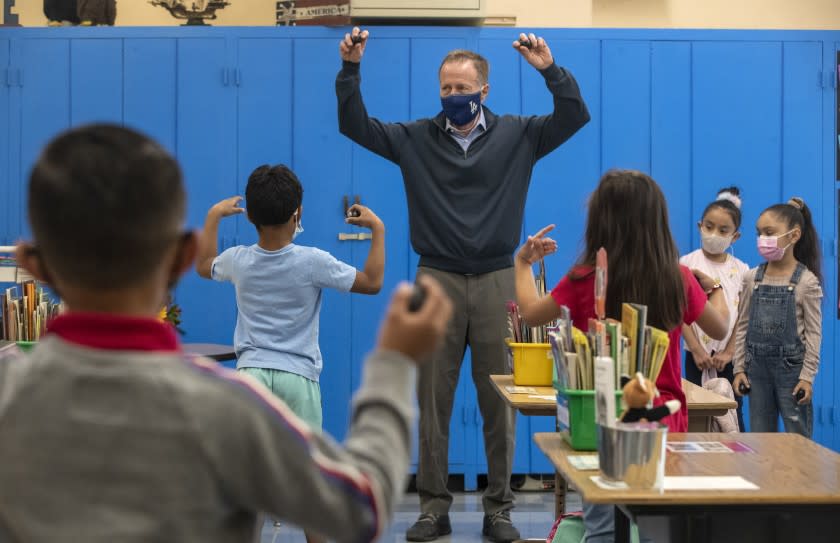California's coronavirus case rate now the lowest in the continental U.S.

California's coronavirus case rate is now the lowest in the continental U.S., an achievement that reflects months of hard-won progress against the pandemic in the aftermath of the state's devastating fall and winter surge.
The state's latest seven-day rate of new cases — 40.3 per 100,000 people — is dramatically lower than the nationwide rate of 135.3 and edged only by Hawaii, 39.1, over the same time period, according to data from the Centers for Disease Control and Prevention.
At the other end of the spectrum is Michigan, which has far and away the highest seven-day case rate in the nation, at 483 per 100,000 people. Others topping that distressing leaderboard are New Jersey, 269.7; Delaware, 264.1; Pennsylvania, 248.5; and Minnesota, 238.4.
Among larger states, the comparable rates over the same time period were 201.1 in Florida and 65.9 in Texas.
While long-term hope continues to spring from the rollout of COVID-19 vaccines, the pandemic still presents a more immediate danger — particularly in areas where cases are on the rise.
"Cases and hospitalizations are increasing in some areas of the country, and cases among younger people who have not yet been vaccinated are also increasing," CDC Director Dr. Rochelle Walensky said during a briefing earlier this week. "Just like all of you, I want to get back to doing the things I love with family and friends who I haven't been able to see over the past year. We all have a role in turning this tide and to trend our cases down."
California, however, has so far avoided the increases seen elsewhere.
Its case rate has been among the lowest in the country for some time, and the numbers reflect the sustained and significant progress the state has made — all the more important as it rushes to vaccinate as many people as quickly as possible and avoid the kind of spikes striking other areas of the country and globe, officials say.
"The work we're doing together and the work you're all doing is having an impact, and we're all so hopeful that we can sustain this trend," Los Angeles County Public Health Director Barbara Ferrer said during a briefing Wednesday.
Over the last week, California has reported an average of 2,320 new cases per day — a 13% decrease from two weeks ago, according to data compiled by The Times.
Last winter, California's average peaked at more than 40,000 new cases per day.
The state's other metrics have also continued to trend in an encouraging direction.
On Tuesday, 1,774 coronavirus-positive Californians were hospitalized statewide, with 437 in intensive care. Though those numbers have yo-yoed slightly day to day, they remain among the lowest the state has seen since last spring.
And over the past week, the state has recorded an average of 81 COVID-19 deaths per day — a still-sobering toll that nevertheless has steadily plunged from the height of the surge, when the average number of daily fatalities was close to 600, Times data show.
California's headway is reflected in its reopenings, as many parts of the state have recently been able to lift coronavirus-related restrictions.
Just this week, Fresno, Santa Barbara, Kings, Calaveras and Mono counties moved into the orange tier — the second-most lenient of the state’s four-category color-coded reopening blueprint.
Doing so will permit a host of businesses in those areas to more widely resume indoor activities, at higher capacities.
Now, 38 of California’s 58 counties have reached the orange tier, and three have entered the final, most-lenient yellow tier. None remain in the strictest purple tier.
On March 9, 34 counties were still in the purple tier, and only four had made it to orange or yellow.
But officials stress that progress isn't permanent, and that it's the collective responsibility of residents and businesses to make sure that allowing additional activity doesn't trigger increases in coronavirus transmission.
“Every member of our community plays an important role in helping us achieve and continue to enjoy the benefits of loosening restrictions," Dr. Henning Ansorg, Santa Barbara County's health officer, said in a statement. "We must continue to be mindful of safety practices including wearing masks, physically distancing, washing hands and getting vaccinated as soon as possible.”
That latter point is particularly important, both to blunt any potential new waves of COVID-19 in the short term and to eventually end the pandemic once and for all.
"All of the information currently available to us does indicate that our vaccines appear to be highly effective in preventing transmission, hospitalizations and deaths, even with the increased presence of variants," Ferrer said.
Providers statewide have administered 27 million vaccine doses to date, and 44% of Californians have already gotten at least one shot, CDC figures show.
More than a quarter of the state's population is fully vaccinated — meaning they've received both required doses of the Pfizer-BioNTech or Moderna vaccines, or got the single-shot Johnson & Johnson vaccine before its administration was paused while federal health officials study a possible link to extremely rare blood clots.
This story originally appeared in Los Angeles Times.

